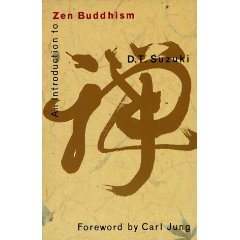 Cover to 1991 Grove Press edition | |
| Author | D.T. Suzuki |
|---|---|
| Subject | Zen Buddhism |
| Publisher | 1934 (Eastern Buddhist Society) |
| Publication place | Japan |
| Media type | |
| Pages | 130 |
| ISBN | 0-8021-3055-0 (1991 edition) |
| OCLC | 23975828 |
| 294.3/927 20 | |
| LC Class | BQ9265.4 .S95 1991 |
| |
| Part of a series on |
| Zen Buddhism |
|---|
 |
An Introduction to Zen Buddhism is a 1934 book about Zen Buddhism by Daisetz Teitaro Suzuki. First published in Kyoto by the Eastern Buddhist Society, it was soon published in other nations and languages, with an added preface by Carl Jung. The book has come to be regarded as "one of the most influential books on Zen in the West". [1]